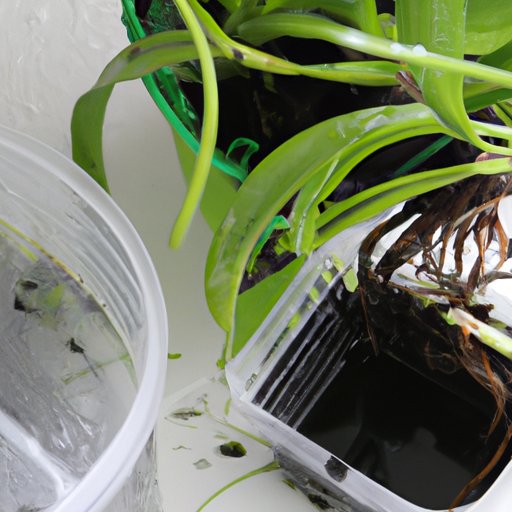I. Introduction
Orchids are one of the most elegant and stunning plants you can have in your home. However, many people shy away from owning them because of the thought that they are hard to care for. But caring for orchids can be easy and enjoyable if you know the basics and how to tend to them properly. This article will give you the knowledge and confidence you need to care for your orchids and ensure they thrive.
It’s important to remember that orchids aren’t all created equal, and they have different requirements to stay healthy and blooming. Understanding these basics will go a long way to keeping your orchids vibrant and radiant for years to come.
II. Starting With The Basics: Understanding Orchids
Before you start caring for orchids, it’s important to identify the type of orchid you have and the care requirements. Different types of orchids need different levels of light, water, and temperature to thrive.
Phalaenopsis orchids are the most common orchids for households, and they thrive in a temperature range of 60-75°F (15-24°C) during the day and 55-65°F (13-18°C) overnight. They also need adequate moisture and indirect sunlight. Dendrobium orchids, on the other hand, need to stay in a warm and humid area to bloom.
When choosing the right orchid for your home, consider the space, temperature, and light availability. If you’re a beginner, start with a Phalaenopsis orchid, as it’s easy to care for and maintain.
III. Watering and Fertilizing: Tips and Tricks
Water and nutrients are essential for the growth and blooming of orchids. However, improper watering and fertilizing can be detrimental to the plant’s health. When watering orchids, the type of water you use is crucial. Tap water often contains chlorine and other minerals that can damage the roots. Use filtered or distilled water for better results.
Overwatering can cause root rot, and not watering enough can lead to dehydration and drying out the plant. It’s recommended to water orchids once a week, but it depends on the humidity, temperature, and type of orchid you have. Make sure the pot has proper drainage and water the roots, not the leaves, to avoid disease and fungus from spreading.
When it comes to fertilizing, orchids have specific requirements: nitrogen, phosphorous, and potassium. You can use a balanced, water-soluble orchid fertilizer every other week during the growing season. It’s important to follow the instructions on the label carefully and not overfertilize, as it can lead to salt buildup and harm the plant.
IV. How to Keep Your Orchid Blooming All Year Round
To keep your orchids blooming healthily, you need to maintain their growth and trim them regularly. Remove yellow or dead leaves to promote new growth and blooming. When an orchid has outgrown its pot or the roots have overgrown, it’s time to repot the plant to ensure optimal growth and health.
Adequate lighting and temperature are also vital for orchids to bloom steadily. Phalaenopsis orchids need bright, indirect light to bloom, while dendrobium orchids need brighter light to thrive and bloom. Keep orchids away from direct sunlight and away from drafts, air conditioning, or heating vents.
V. Orchid Diseases and How to Prevent Them
Orchids can be susceptible to diseases and pests. Common orchid diseases to watch out for include root rot, bacterial infections, and spider mites. To prevent disease from spreading to other plants, remove the infected portions of the plant and isolate it from others.
Regular inspection and cleaning of your orchids can prevent plant diseases. Make sure to remove dead leaves, flowers, and other plant debris that can promote pest infestation and fungal growth. If you notice any signs of damage or infestation, quickly remove the affected parts and treat the orchid with the recommended products. When using pesticides, choose products that won’t harm the plant, and follow the instructions on the labels.
VI. Understanding When Your Orchid Needs Repotting
Orchids need repotting when the roots outgrow the pot or the medium has broken down and doesn’t provide nutrients or aeration anymore. Signs that your orchid needs repotting include a yellowing or wilting plant, tightened roots, or insufficient blooming.
When repotting, be gentle not to damage the stems and roots. You can use a new orchid pot with adequate drainage and orchid bark mix for better growth. After repotting, water the plant and place it in an area with adequate lighting and temperature.
VII. Orchid Care For Beginners
Caring for orchids can be overwhelming for beginners, but with a few simple tricks, you can promote healthy growth and blooming. Choose the appropriate pot size for your orchid, as it can affect the plant’s health and blooming. The orchid pot should have adequate drainage and provide adequate room for the roots to grow.
The best time to plant orchids is during the spring when the plant is actively growing. During this time, you can easily inspect the roots for disease or infestation and repot if needed. Additionally, if you’re new to orchid care, start with a Phalaenopsis orchid, as it’s the easiest to care for and maintain.
Simple tricks to promote healthy growth include providing adequate lighting, watering the plant weekly with distilled or filtered water, and adding orchid fertilizer every two weeks during the growing season.
VIII. Conclusion
In conclusion, taking care of orchids can be easy and enjoyable if you know the basics and how to tend to them properly. Understanding the different types of orchids and their care requirements, watering and fertilizing techniques, trimming tips, and how to prevent diseases can help you keep your orchids blooming and healthy all year round.
By following these tips and tricks, you’ll be able to take care of orchids with confidence and have stunning, elegant plants in your home.
